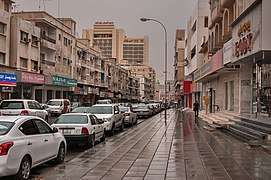Mushayrib
Mushayrib (Arabic: مشيرب; also spelled Musheireb) is a district in Qatar, located in the municipality of Ad Dawhah.[1] As of the 2010 census, the former district of Al Asmakh has been integrated into Mushayrib.[2][3] It is one of the oldest districts of Doha, and contains Al Kahraba Street (also called Electricity Street), the country's first fully lit street.[4]
Musheireb مشيرب | |
|---|---|
District | |
 Musheireb skyline in 2012 | |
 Musheireb  Musheireb | |
| Coordinates: 25°17′N 51°31′E | |
| Country | |
| Municipality | Ad-Dawhah |
| Zone | Zone 3, Zone 4, Zone 13 |
| District no. | 4 |
| Area | |
| • Total | 1.0 km2 (0.4 sq mi) |
| Population | |
| • Total | 22,711 |
| • Density | 23,000/km2 (59,000/sq mi) |
History
In J. G. Lorimer's Gazetteer of the Persian Gulf first published in 1908, Mushayrib was described as a place where the town of Al Bidda obtained its water supply from, but described the water as brackish and scanty.[5] Lorimer noted that it appeared to accommodate one of the only seven sizable date palm plantations in Qatar.[6]
The majority of Mushayrib's residents are expat workers. In 2014, the government forcibly evicted several hundred residents from the neighborhood in preparation for the development of several new up-scale buildings and the demolition of older buildings.[7]
Localities
Al Asmakh
Formerly a stand-alone district, Al Asmakh has been amalgamated into Mushayrib since the 21st century.[2][3] Al Asmakh was initially recognized as a formal district of Doha around the 1930s. Located near Souq Waqif, it covers an area of about 326,000 sq m². Although most of its historic architecture has been degraded or demolished, there remains some standing buildings which date back to the early 20th century. Currently, it is populated mainly by migrant workers. Residential housing in the area is tightly packed and the streets are relatively narrow.[8]
Msheireb Downtown Doha
The Msheireb Downtown Doha project was launched in January 2010 with the end goal of a complete overhaul and refurbishment of the district.[9] It is a $5.5 billion project,[10] covering an area of 31 hectares (77 acres) (310,000 square metres), and was launched in six phases.[11]
Transport
The underground Msheireb station serves the Doha Metro's Red Line, Green Line and Gold Line. Launched in May 2019, it is the country's largest metro station. It is located in Msheireb Downtown Doha, at the intersection of Wadi Msheireb and Al Diwan Street.[12]
Demographics
As of the 2010 census, the district comprised 6,745 housing units[13] and 1,009 establishments.[14] There were 22,711 people living in the district, of which 83% were male and 17% were female. Out of the 22,711 inhabitants, 88% were 20 years of age or older and 12% were under the age of 20.[15]
Employed persons made up 79% of the total population. Females accounted for 4% of the working population, while males accounted for 96% of the working population.[15]
| Year | Population |
|---|---|
| 1986[16] | 7,333 |
| 1997[17] | 7,914 |
| 2004[2] | 9,655 |
| 2010[1] | 22,711 |
Gallery
.jpg) Crosswalk in Musheireb.
Crosswalk in Musheireb. Abdulla Bin Thani Street in Mushayrib during rain in 2013.
Abdulla Bin Thani Street in Mushayrib during rain in 2013..jpg) Aerial view of Musheireb in 2019.
Aerial view of Musheireb in 2019.
References
- "2010 population census" (PDF). Qatar Statistics Authority. Archived from the original (PDF) on 2 April 2015. Retrieved 29 June 2015.
- "2004 population census". Qatar Statistics Authority. Archived from the original on 24 September 2015. Retrieved 1 July 2015.
- Chantelle D'Mello (5 July 2014). "Three days later, Musheireb residents still struggling after eviction". Doha News. Retrieved 7 August 2015.
- David Lepeska (1 January 2010). "Shifting a paradigm in Doha". The National. Retrieved 9 December 2019.
- "'Persian Gulf Gazetteer Part II, Geographical and Descriptive Materials, Section II Western Side of the Gulf' [55v] (113/286)". Qatar Digital Library. Retrieved 23 July 2015.
- "'Gazetteer of the Persian Gulf. Vol. II. Geographical and Statistical. J G Lorimer. 1908' [1526] (1641/2084)". Qatar Digital Library. Retrieved 6 July 2018. This article incorporates text from this source, which is in the public domain.
- Chantelle D'Mello (2 July 2014). "Hundreds of low-income expats in Qatar left homeless after eviction". Doha News. Retrieved 15 August 2015.
- Djamel Boussaa (May 2014). "Al Asmakh historic district in Doha, Qatar: From an urban slum to living heritage". Journal of Architectural Conservation. 20 (1): 2–15. doi:10.1080/13556207.2014.888815. Retrieved 26 December 2015.
- "Carillion and QBC land $650m Msheireb contract". Construction Week Online. 6 December 2011. Retrieved 15 August 2015.
- "Msheireb Properties awards QR1.5 billion construction contract to Brookfield Multiplex Medgulf WLL" – via Al Bawaba.
- "Carillion and QBC land $650m Msheireb contract" – via Construction Week Online.
- "Msheireb Metro Station". corp.qr.com.qa. Retrieved 2019-11-24.
- "Housing units, by type of unit and zone (April 2010)" (PDF). Qatar Statistics Authority. Archived from the original (PDF) on 8 July 2015. Retrieved 7 August 2015.
- "Establishments by status of establishment and zone (April 2010)" (PDF). Qatar Statistics Authority. Archived from the original (PDF) on 8 July 2015. Retrieved 7 August 2015.
- "Geo Statistics Application". Ministry of Development Planning and Statistics. Archived from the original on 11 September 2012. Retrieved 7 August 2015.
- "1986 population census" (PDF). Qatar Statistics Authority. Archived from the original (PDF) on 3 July 2015. Retrieved 2 July 2015.
- "1997 population census" (PDF). Qatar Statistics Authority. Archived from the original (PDF) on 29 May 2015. Retrieved 2 July 2015.